 |
 |
 |
 |
 |
 |
| Chiefs of Clan Oliphant |
| Above (right) are the arms of the Chief of the Oliphants (being the "undifferenced" arms, literally unchanged.) The style of the Chief is "Oliphant of Oliphant" or "Oliphant of that Ilk" (meaning of the same name). The chiefly branch were created Lords Oliphant (no later than July, 1455). Douglas's Peerage states that the first known Chief was Donald Holifard, a Norwegian nobleman who was shipwrecked on Scotland's East coast in the 9th Century. However, proof so far found, suggests that David Olifard, who saved the life of King David I (his godfather) at the siege of Winchester in 1141, was in fact the first of the name to come to Scotland. He was ancestor of Sir William Oliphant who defended Stirling Castle from Edward I during the Wars of Independence and Laurence Oliphant, younger of Gask, who fought at Culloden and was Bonnie Prince Charlie's Aide de Camp (ADC). In 1633, following the death of the fifth Lord Oliphant, there was a dispute over the succession of the peerage. It went to court and was decided by the King, who ruled that two peerages would be created out of the one. The original precedence (seniority) of this lordship would pass through his daughter to her husband, who the King then made Lord Mordington. The male heir Patrick, Master of Oliphant was then created 6th Lord Oliphant by a new patent. The terms of this new title were that it should descend to "heirs male of his body" (i.e. his direct descendants). The 10th and last Lord Oliphant died in 1748 (being the last male descendant of Patrick). The peerage is now irrecoverably lost to lines branching off any earlier than the 6th Lord, such as Gask and Condie. The chiefship none the less, continues. Although a Lordship follows a strict order of succession, a chiefship can be left to whomsoever the Chief appoints (provided that it is not entailed and provided that they carry the name or, being of the blood, change their name to that of the clan they wish to take up the chiefship of.) The next in line was William Oliphant, a descendant of the Oliphants of Turin, Drimmie and Langton, who also claimed the peerage. Unknown to him, it was extinct but he was the rightful chief. The Oliphant chiefship was left by the last Lord to the Gask branch of the family (the first Chief of Clan Oliphant from the Gask branch being Laurence, 6th of Gask). The chiefship continued in that branch until the 1820s when James Oliphant of Gask (and of Oliphant) died without a known male heir . The chiefship was left to his "heir male whomsoever" (his closest male relative, PROVIDED that this relative was descended in the male line). However, the title of Oliphant of Gask passed through the female line (see Branches), thus separating the bearer of the two titles. Below is a list of known Clan Chiefs. Click on the B for a biography, and on the P for the Chiefs listing (if available) from the Scots Peerage. It should be noted that the lineage from # 10 Sir William Oliphant is widely known, however previous to this there are many differing accounts. Line of known Clan Chiefs and the line before arriving in Scotland:- Roger Olifard (the first person to use this surname, circa 1090) William Olifard held the lands of Lilford, Northants. Died before 1157. 1)David Olifard (Justicar of the Lothians, Godson of David I of Scotland. Owned Lilford). P 2)David Olifard (Justicar of the Lothians; not proven but dates indicate that there might have been two Davids) 3) Sir Walter Olifard (Justicar of the Lothians, son of David 2) 1178 P 4) Walter Olifard (Justicar of the Lothians, son of Walter 3) P 5) David Olifard (owned Lilford. Son of Walter 4) P 6) Sir William Olifard (cousin of Walter 4) 7) Sir William Olifard (son of Sir William 6)B P 8) Sir William Olyfaunt (defender of Stirling Castle 1304. Son of William 7) P 9) Sir Philip, may have succeeded him (brother of Sir William Olifard 7) 10)Sir William Olyfaunt of Dupplin and then of Aberdalgie (son of Sir Philip 9) 11) Sir Walter Oliphant of Aberdalgie, married Elizabeth, dau. of Robert I of Scotland (son of William 10) P 12) Sir John Oliphant of Aberdalgie (son of Walter 11) P 13) Sir William Oliphant of Aberdalgie (son of John 12) P 14) Sir John Oliphant of Aberdalgie (son of William 13) P 15) Laurence, 1st Lord Oliphant (son of John 14) B P 16) John, 2nd Lord Oliphant (son of Laurence 15) P 17) Laurence, 3rd Lord Oliphant (grandson of John 16)* B P 18) Laurence, 4th Lord Oliphant (son of Laurence 17) B P 19) Laurence, 5th Lord Oliphant (grandson of Laurence 18)** P 20) Patrick, 6th Lord Oliphant (grandson of Laurence 18) P 21) Charles, 7th Lord Oliphant (son of Patrick 20) P 22) Patrick, 8th Lord Oliphant (son of Charles 21) P 23) William, 9th Lord Oliphant (son of Patrick 22) P 24) 10th Lord Oliphant (grandson of Patrick 22) P 25) Laurence Oliphant, 6th Laird of Gask (6x great grandson of John 16) B 26) Laurence Oliphant, 7th Laird of Gask (son of Laurence 25) 27) Laurence Oliphant, 8th Laird of Gask (son of Laurence 26) 28) Laurence Oliphant, 9th Laird of Gask (son of Laurence 27) 29) James Blair Oliphant, 10th Laird of Gask (son of Laurence 27) 30) Laurence Oliphant, 8th of Condie (8 x great grandson of John 16) 31) Gen Sir Laurence James Oliphant 9th of Condie and of Newton (son of Laurence 30) 32) Capt. Henry Gerard Laurence Oliphant 10th of Condie (son of Laurence 31) 33) Lt-Cdr Ralph Henry Hood Laurence Oliphant 11th of Condie, RN (son of Laurence 32) 34) Richard Eric Laurence Oliphant of That Ilk and of Condie (gg grandson of brother of 30) * son of Colin, Master of Oliphant, whose death at the Battle of Flodden preceded his father's, and therefore was never Chief. ** son of Laurence, Master of Oliphant, who was forced to flee Scotland before his father's death, and therefore was also never Chief. |
 |
| Although the chiefship was in abeyance after James died in the 1820's, this has now been resolved by the interlocutor handed down by the Lord Lyon, King of Arms in Scotland dated 12th June 2003, confirming the claim in the male line of Richard Oliphant of Condie (and thus his forbears from Laurence, 8th of Condie.) However, as the only line whose ancestors maintained the single name of Oliphant from within the required period of 1 year of the chiefship becoming open to them, by virtue of the marriage with the Oliphants of Gask and theirs before that with the Lords Oliphant lines, Richard is also probably the best claimant in the female line also. For instance, the entail attaching to Ardblair meant that, in order to inherit that (Blair) estate, the female line of the Oliphants of Gask have had to maintain the hyphenated name Kington-Blair-Oliphant or Blair-Oliphant for over 140 years. There are currently two other chieftains, each head of a branch within a Clan but subordinate to the Clan Chief. These two are Laurence Kington Blair Oliphant of Ardblair and Gask and, John Olipant of Rossie (see Chieftains) The Claim made by Richard Oliphant of Condie, having been advertised publicly in the press and duly notified personally to Laurence Kingto Blair Oliphant of Ardblair and Gask, with the requirement that anyone who thought they had a claim should respond to the Lord Lyon within 21 days, went unchallenged by any other claim at the Lyon Court. Although the claim then had to be proven on its own account, these notices were much corrupted by media sources and the least inaccurate report can be found at http://www.timesonline.co.uk/newspaper/0,,170-759192,00.html |
 |

